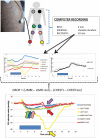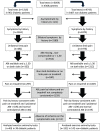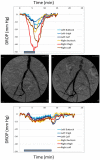High prevalence of exercise-induced ischemia in the asymptomatic limb of patients with apparently strictly unilateral symptoms and unilateral peripheral artery disease
- PMID: 30803404
- PMCID: PMC6348574
- DOI: 10.1177/1753944718819063
High prevalence of exercise-induced ischemia in the asymptomatic limb of patients with apparently strictly unilateral symptoms and unilateral peripheral artery disease
Abstract
Background:: The prevalence of exercise-induced ischemia in the asymptomatic limb of patients with unilateral claudication based on history and treadmill evaluation, and with unilateral ipsilateral peripheral artery disease (i.e ankle-to-brachial systolic pressure index <0.90) is unknown.
Methods:: We detected exercise-induced ischemia in the asymptomatic limb of patients with apparently unilateral claudication. Among 6059 exercise-oximetry tests performed in 3407 nondiabetic and 961 diabetic patients. We estimated the intensity of ischemia in the both limb (buttocks and calves) using the lowest minimum value of the decrease from rest of oxygen pressure (DROP; limb changes minus chest changes from rest), with significant ischemia defined as DROP lower than -15 mmHg.
Results:: We found 152 tests performed in 142 nondiabetic patients and 40 tests performed in 38 diabetic patients. The asymptomatic limb showed significant ischemia in 46.7% and 37.5% of the tests. Strictly unilateral exercise-induced claudication with apparently unilateral peripheral artery disease was rare (<4% of all tests). However, among these highly selected tests, significant ischemia was found in the asymptomatic limb in more than one-third of cases.
Conclusion:: The asymptomatic limb of patients with peripheral artery disease should not be considered a normal limb.
Keywords: claudication; diabetes mellitus; exercise; lower limb; transcutaneous oxygen pressure; treadmill testing; walking impairment.
Conflict of interest statement
Figures



Similar articles
-
Prevalence and Causes of Normal Exercise Oximetry in the Calf in Patients with Peripheral Artery Disease and Limiting Calf Claudication.Eur J Vasc Endovasc Surg. 2016 Apr;51(4):572-8. doi: 10.1016/j.ejvs.2015.12.040. Epub 2016 Feb 20. Eur J Vasc Endovasc Surg. 2016. PMID: 26905471
-
Identification of new factors associated to walking impairment in patients with vascular-type claudication.Vascular. 2019 Jun;27(3):260-269. doi: 10.1177/1708538118813708. Epub 2018 Nov 15. Vascular. 2019. PMID: 30442076
-
Calf muscle stimulation with the Veinoplus device results in a significant increase in lower limb inflow without generating limb ischemia or pain in patients with peripheral artery disease.J Vasc Surg. 2013 Mar;57(3):714-9. doi: 10.1016/j.jvs.2012.08.117. Epub 2013 Jan 9. J Vasc Surg. 2013. PMID: 23312939 Clinical Trial.
-
[Diagnosis of lower limb peripheral artery disease].Presse Med. 2018 Jan;47(1):47-55. doi: 10.1016/j.lpm.2017.09.021. Epub 2017 Dec 19. Presse Med. 2018. PMID: 29273183 Review. French.
-
Clinical application of transcutaneous oxygen pressure measurements during exercise.Atherosclerosis. 2018 Sep;276:117-123. doi: 10.1016/j.atherosclerosis.2018.07.023. Epub 2018 Jul 19. Atherosclerosis. 2018. PMID: 30059842 Review.
Cited by
-
Location of ischemia and ischemic pain intensity affect spatiotemporal parameters and leg muscles activity during walking in patients with intermittent claudication.Sci Rep. 2021 Mar 24;11(1):6809. doi: 10.1038/s41598-021-86351-7. Sci Rep. 2021. PMID: 33762658 Free PMC article.
-
A low-cost, wireless near-infrared spectroscopy device detects the presence of lower extremity atherosclerosis as measured by computed tomographic angiography and characterizes walking impairment in peripheral artery disease.J Vasc Surg. 2020 Mar;71(3):946-957. doi: 10.1016/j.jvs.2019.04.493. Epub 2019 Aug 21. J Vasc Surg. 2020. PMID: 31445826 Free PMC article.
References
-
- Hiatt WR. Medical treatment of peripheral arterial disease and claudication. N Engl J Med 2001; 344: 1608–1621. - PubMed
-
- Kroger K, Stang A, Kondratieva J, et al. Prevalence of peripheral arterial disease - results of the Heinz Nixdorf recall study. Eur J Epidemiol 2006; 21: 279–285. - PubMed
-
- Criqui MH, Fronek A, Barrett-Connor E, et al. The prevalence of peripheral arterial disease in a defined population. Circulation 1985; 71: 510–515. - PubMed
-
- Aboyans V, Criqui MH, Abraham P, et al. Measurement and interpretation of the ankle-brachial index: a scientific statement from the American Heart Association. Circulation 2012; 126: 2890–2909. - PubMed
-
- Norgren L, Hiatt WR, Dormandy JA, et al. Inter-Society Consensus for the Management of Peripheral Arterial Disease (TASC II). J Vasc Surg 2007; 45(Suppl. S): S5–S67. - PubMed
MeSH terms
LinkOut - more resources
Full Text Sources
Medical

